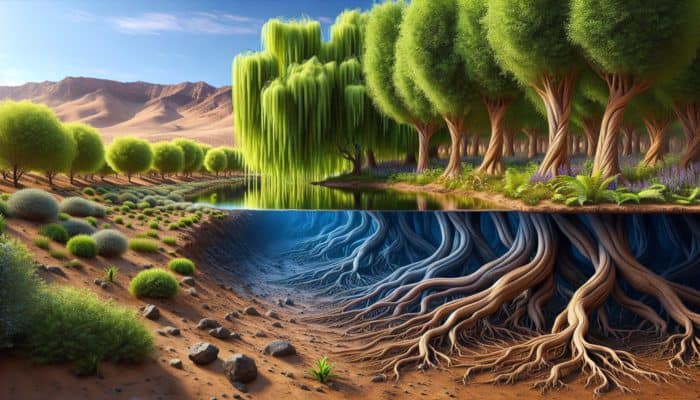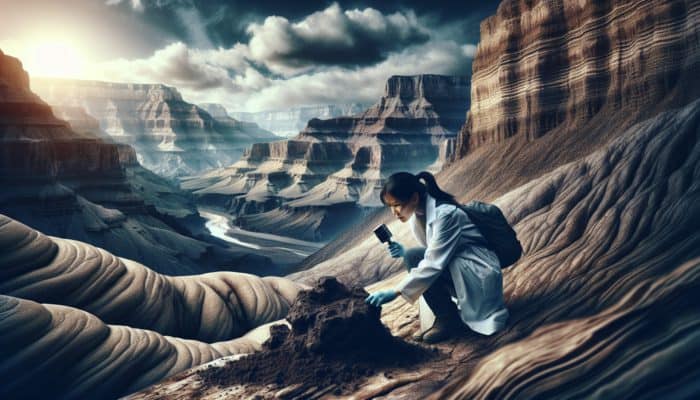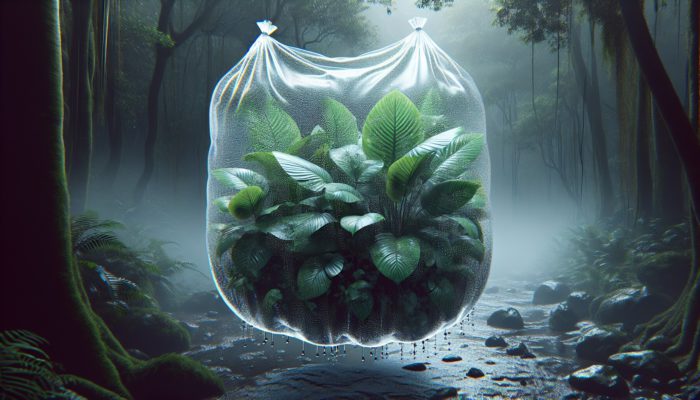Mastering the Art of Locating Natural Water Sources for Survival Situations
Leveraging Vegetation as Essential Indicators of Water Availability

When embarking on the quest for finding water in nature, the presence of vibrant green vegetation serves as a powerful indicator of nearby water sources. Across various ecosystems, particular plants like willows, alders, and certain ferns flourish in close proximity to water. These species are adapted to thrive with deep root systems that tap into underground aquifers or surface water, demonstrating their crucial role as reliable markers of hydration potential. By observing the variety and density of foliage surrounding you, you can pinpoint potential water sources. In arid regions such as the Sahara Desert, the acacia tree is renowned for thriving where groundwater lies, serving as a vital resource for both wildlife and human inhabitants.
Moreover, numerous medicinal plants, especially those integral to traditional medicine practices found within the Amazon rainforest, often grow in close association with water sources. Their presence not only indicates accessible hydration but also showcases a rich biodiversity that flourishes in these moist habitats. The connection between flora and water sources can be observed globally, from the lush wetlands of Florida to the verdant valleys of the Himalayas, highlighting the essential role of water in sustaining diverse forms of life.
As you navigate through wilderness environments, it’s imperative to remain attuned to how vegetation varies in response to the landscape. Areas abundant in dense, thriving plant life typically indicate the presence of streams, ponds, or underground water. By honing your ability to recognise distinct plant types and their habitats, you can significantly enhance your skills in finding water in nature effectively.
Deciphering Animal Behaviour to Reveal Water Sources
Animals possess an innate ability to locate water sources, often offering invaluable clues for those in search of hydration. For instance, you may notice that birds congregate near water during the early morning or late afternoon when they are most active. By carefully observing wildlife patterns, you can detect their movement trails; animals frequently create paths leading directly to water sources, which can guide you to hidden oases or watering holes.
In regions such as Africa, elephants have been seen digging into riverbeds to access underground water during dry spells. Their actions not only showcase their intelligence but also point to potential water sources that might otherwise remain hidden. Similarly, in the Australian Outback, kangaroos and various other wildlife seek refuge in dense thickets during the hottest parts of the day, returning to water sources at dawn and dusk.
Furthermore, monitoring insect behaviour can provide additional insights into nearby water availability. For example, mosquitoes breed in stagnant water, whereas butterflies are often found near damp areas in search of hydration. Developing the skill to interpret these behaviours will deepen your understanding of the landscape and the subtle cues offered by the ecosystem, significantly increasing your chances of discovering water sources.
Evaluating Topographical Features to Discover Water Sources
A comprehensive understanding of the terrain is essential when searching for water in nature. Since water naturally flows downhill, valleys and low-lying areas are excellent starting points in your quest for hydration. Observing changes in elevation can also be beneficial; lower regions often accumulate runoff and may lead to concealed streams or ponds. Features such as valleys, ravines, and cliff edges are often strong indicators of the presence of nearby water sources.
In mountainous regions like the Rocky Mountains and the Andes, snowmelt creates streams that flow through these valleys. The presence of lush vegetation on valley floors is a strong signal that water is readily available nearby. Similarly, in coastal areas, the topographical structure may reveal hidden aquifers or springs that sustain adjacent wetlands. Understanding how landforms interact with water flow can greatly improve your likelihood of success in your search for hydration.
Moreover, unique geological formations, such as limestone karsts, frequently conceal underground rivers. By thoroughly studying the landscape, you can identify potential locations where water may collect or flow, as commonly seen in regions throughout Southeast Asia. This knowledge is vital for outdoor enthusiasts and survivalists, providing a strategic approach to finding water in nature.
Examining Soil and Rock Formations to Reveal Water Indicators

The characteristics of soil and rock formations can offer significant insights regarding water availability. Moist, dark soil typically indicates that water lies close to the surface, while sandy or dry soils might suggest that deeper digging is necessary. Observing the soil texture can guide your search; for instance, clay-rich soils tend to retain moisture, making them strong indicators of nearby water sources.
Rock formations can also provide critical clues. Water-carved rocks or smooth, rounded stones indicate a historical presence of flowing water. Many rivers and streams leave distinct marks on rocks, such as worn edges or polished surfaces, indicating that water has significantly shaped the landscape over time. In areas like the Grand Canyon, these geological features tell the story of ancient water flow, assisting modern explorers in their quest for hydration.
Additionally, specific mineral deposits found within rock formations can signal the presence of water. Regions rich in minerals, such as quartz, may lead to springs or aquifers. Exploring these geological features can uncover hidden treasures from nature, paving the way to successfully finding water in the wilderness and ensuring survival.
Proven Techniques for Collecting Water in Natural Settings
Effective Strategies for Digging for Water
When on the lookout for water in arid regions, digging in dry riverbeds or low-lying areas can often yield surprisingly fruitful results. Underground water is frequently located just beneath the surface, with its depth varying according to soil type, seasonal fluctuations, and environmental conditions. For example, in sandy soils, water may be only a few feet below, while in clay soils, deeper excavation might be required to access it.
Adopting a systematic approach to your digging process is crucial. Begin by identifying potential sites near vegetation or animal trails, as these areas typically correlate with water access. Once you have pinpointed a suitable site, you can use a shovel or even your hands to dig. If the soil is dry, it may take considerable effort to reach moisture, but patience often rewards the diligent seeker.
In deserts or dry landscapes, timing your digging is essential. During the hottest parts of the day, water may evaporate rapidly; therefore, attempting to dig during the cooler early morning or late afternoon hours can significantly improve your chances of success. Additionally, if you come across a pocket of water while digging, having containers ready for collection is crucial. This method of finding water in nature can be invaluable, particularly when traditional water sources are scarce.
Utilising Vegetation for Effective Water Collection

Using vegetation for water collection is both a sustainable and practical approach. One particularly effective technique is the creation of a transpiration bag. This method involves enclosing leafy branches in clear plastic bags, allowing the natural process of transpiration to collect moisture. As plants release water vapour during photosynthesis, this vapour condenses on the inner surface of the bag, resulting in collected liquid water.
This approach is especially effective in tropical and humid environments, where the transpiration rates of plants are significantly higher. For instance, in the Amazon rainforest, large-leafed plants can yield considerable amounts of water, creating a natural reservoir for individuals in need. Furthermore, this technique does not harm the plant; rather, it promotes awareness of sustainable practices.
Another method involves utilising large, succulent plants such as cacti. These plants store water within their tissues, and knowing how to access this resource can be a lifesaver. By carefully slicing open a cactus, you can reach the moisture inside, providing immediate hydration. However, caution is advised, as some cacti contain toxins that may be harmful if ingested.
Overall, strategically employing vegetation can significantly enhance your ability to effectively find water in the wild. By understanding plant biology and leveraging natural processes, you can develop sustainable methods to ensure hydration while exploring diverse landscapes.
Constructing a Solar Still for Efficient Water Extraction
Building a solar still is an ingenious technique for extracting water from the ground or plant materials by harnessing the sun's heat. This method proves particularly beneficial in arid environments where traditional water sources may be limited. To create a solar still, gather essential materials: a container for collecting water, a waterproof sheet, and a small rock.
Begin by digging a shallow hole and placing a container at the bottom. Next, cover the hole with the waterproof sheet, ensuring that it is airtight. Place a small rock in the centre of the sheet to create a dip, allowing condensation to gather and drip into the container below. As the sun heats the soil, moisture will evaporate and condense on the underside of the sheet, ultimately dripping into the container.
This method can yield drinkable water, even in the driest conditions. Solar stills are effective because they utilise the natural processes of evaporation and condensation, transforming raw sunlight into a vital resource. Moreover, they require minimal resources, making them accessible for wilderness explorers and survivalists alike.
When using solar stills, it’s crucial to ensure that the collection container is clean to avoid potential contamination. The process may take several hours, so patience is essential. Mastering the construction and effective use of a solar still broadens your toolkit for finding water in nature, emphasising innovation and sustainability.
Harvesting Rainwater for Sustainable Water Collection
Harvesting rainwater is one of the most efficient methods for securing water, particularly in regions that receive regular rainfall. Setting up a rain collection system can significantly enhance your chances of obtaining a sustainable water source. Start by positioning clean containers, tarps, or gutters strategically to capture rainfall. The key is to ensure these items are free from contaminants, as dirty surfaces can compromise the quality of the collected water.
When it rains, containers can quickly fill up, especially during heavy showers. Across various cultures, rainwater harvesting has been a traditional practice integral to agricultural success. For instance, in India, rainwater is collected during the monsoon season and stored for use during the dry months, illustrating its importance as a sustainable resource.
Upon collection, it is essential to store rainwater in sealed containers. Keeping it in a cool, dark place helps prevent bacterial growth and maintain water quality. It’s also wise to regularly check for any signs of contamination or algae growth in the stored water.
Purifying rainwater is advisable, even though it is generally clean. Boiling or using chemical treatments can help ensure safety before consumption. The practice of rainwater harvesting not only aids in finding water in nature but also promotes sustainability, optimising natural resources for future use.
Collecting Dew as an Alternative Water Source
Gathering dew is a simple yet effective method for obtaining water in humid environments. Dew forms overnight as temperatures drop, leading to condensation that settles onto surfaces. To maximise your collection efforts, spread clean cloths or absorbent materials in open areas before sunset. The following morning, you can easily wring them out to collect fresh water.
This method proves particularly useful in regions with high humidity, such as tropical forests or coastal areas. The volume of water collected can be surprisingly substantial, especially when using multiple cloths across various locations. Additionally, employing sponges or other absorbent materials can further enhance your water collection efforts, as they can soak up moisture directly from surfaces.
To effectively collect dew, timing is critical. Early mornings, before the sun has fully risen, yield the best results, as this is when dew is most abundant. Understanding the patterns of dew formation allows for strategic collection, benefiting those on long hikes or outdoor adventures.
Dew collection not only provides essential hydration but also fosters an appreciation for the intricate ecosystems that yield this natural resource. By focusing on straightforward and eco-friendly methods, you can significantly enhance your ability to locate water in nature, even in seemingly dry conditions.
Crucial Purification Techniques for Collected Water
Employing Boiling as a Reliable Water Purification Method
Boiling water remains one of the most dependable methods for purifying water, effectively killing pathogens, bacteria, and viruses. When collecting water in the wild, it’s vital to ensure that any collected water reaches a rolling boil for at least one minute. At higher elevations, where boiling points decrease, it’s advisable to extend the boiling time to three minutes for thorough purification.
Boiling is a straightforward process that requires minimal equipment; a portable stove or even a campfire can suffice. Using a metal container, such as a pot or canteen, facilitates effective heat transfer, ensuring the water reaches the necessary temperature. This method is advantageous as it doesn’t involve any special chemicals or equipment, making it accessible to anyone in the field.
However, boiling does not eliminate chemical contaminants or sediment. Therefore, pre-filtering water through cloth or sand can enhance the purification process, particularly in areas with visible debris. This two-step approach ensures that the water is not only safe to drink but also visually appealing.
In survival situations, having a fire-making kit and a metal container can be invaluable. Boiling water not only protects against illness but also instills confidence while navigating remote landscapes, emphasising the importance of robust purification techniques when finding water in nature.
Exploring Chemical Treatment as an Effective Water Purification Method
Chemical treatment represents another effective method for purifying water, particularly when boiling is not a feasible option. Water purification tablets, typically containing chlorine or iodine, are widely available and easy to use. Following the manufacturer’s instructions is crucial, as dosage and wait times can vary based on the specific product.
This method is particularly beneficial for backpackers and travellers who may lack access to boiling equipment. Simply adding the appropriate number of tablets to a designated amount of water allows for straightforward purification. While effective, it’s important to consider that some individuals may have sensitivities to iodine or chlorine; thus, having alternative methods or treatments could be beneficial in these situations.
In addition to tablets, liquid chemical treatments can also be employed to disinfect water. It’s essential to ensure the water is clear before treatment, as turbidity can hinder the efficacy of the treatment. Pre-filtering the water can enhance the effectiveness of chemical treatments, making this a practical combination of methods to guarantee the production of safe drinking water.
Understanding the various chemical treatment options available empowers individuals to make informed choices while finding water in nature. This enhances overall safety during outdoor adventures and underscores the necessity for thorough preparation.
Utilising Filtration Systems for Clean Water Access
Portable filtration systems have revolutionised how we purify water in the wilderness. These devices effectively remove bacteria, protozoa, and sediment, ensuring that collected water is safe to consume. When selecting a filter, look for systems with a pore size of 0.2 microns or smaller, as this guarantees the removal of most pathogens.
There are various types of filtration systems available, ranging from gravity-fed filters to hand-pump models. Gravity filters are particularly efficient, allowing water to pass through without requiring manual effort. They are ideal for camping and group trips, as they can purify larger quantities of water in a short time.
When using a portable filter, it’s vital to adhere to the manufacturer’s instructions for maintenance and usage to ensure optimal performance. Regular cleaning and replacing filter cartridges can prevent contamination and maximise the lifespan of the device.
Furthermore, understanding the limitations of filtration systems is paramount. While effective against many pathogens, some filters may not effectively remove viruses. In such cases, combining filtration with chemical treatment can enhance safety and ensure that the water collected during your adventures is both safe and refreshing.
Investing in a high-quality filtration system can be a game-changer for outdoor enthusiasts, empowering them to confidently find water in nature while focusing on exploration and enjoyment.
Exploring Ultraviolet (UV) Light Purification for Enhanced Water Safety
Ultraviolet (UV) light purification has emerged as a highly effective method for disinfecting water. UV light effectively kills bacteria, viruses, and other pathogens by altering their DNA, rendering them harmless. Portable UV purifiers are widely available and easy to use, making them an excellent choice for travellers and explorers.
To utilise a UV purifier, fill a container with water, insert the UV device, and follow the manufacturer’s guidelines. Depending on the model, the water may require exposure to UV light for several minutes to ensure effective purification. This method is particularly advantageous because it does not alter the water's taste and does not require additional chemicals.
However, it’s essential to recognise that UV purification does not eliminate sediment or chemical contaminants. Therefore, pre-filtering water is recommended, especially in areas where water quality may be questionable.
Understanding how to harness the power of UV purification can significantly enhance your ability to find safe drinking water in various environments. This modern approach to water purification emphasises innovation and sustainability, aligning with contemporary practices in outdoor survival and exploration.
Implementing Rainwater Harvesting for a Sustainable Water Supply
Effective Strategies for Collecting Rainwater
Collecting rainwater is a sustainable and practical method for securing a water supply, particularly in regions with regular rainfall. Setting up a collection system requires careful planning to maximise the amount collected while ensuring cleanliness. Clean containers, tarps, or specially designed rainwater collection systems can significantly enhance your ability to gather this precious resource.
To begin, position containers in areas where rain typically falls, ensuring they are free from contaminants. Tarps can be laid out to funnel rainwater into designated containers, while gutters can direct rainfall from rooftops into barrels. In many cultures, rainwater harvesting is a long-standing tradition, highlighting its effectiveness as a water source.
The beauty of rainwater lies in its purity, often requiring minimal treatment. However, it’s wise to treat collected rainwater before consumption, particularly if it has been stored for an extended period. Boiling or utilising chemical treatments can eliminate any potential contaminants that might have settled in the storage container.
Understanding the significance of rainwater harvesting not only aids in finding water in nature but also promotes a sustainable lifestyle. By embracing this practice, individuals can contribute to water conservation while preparing for dry spells or emergencies.
Best Practices for Storing Rainwater Safely
Proper storage of collected rainwater is crucial for maintaining its quality and safety. Using sealed, clean containers helps prevent contamination and keeps the water free from bacteria and algae. When selecting storage containers, look for those made from food-grade materials that are resistant to UV light, as this can degrade water quality over time.
Storing rainwater in a cool, dark place is essential to prevent bacterial growth. Regularly check the storage containers for signs of contamination or algae, and clean them as necessary. This practice not only ensures safe drinking water but also prolongs the lifespan of your collected resource.
Implementing rainwater storage systems can enhance long-term water availability, especially in regions with fluctuating rainfall patterns. Utilising barrels, cisterns, or even underground tanks can optimise space and capacity for storing collected rainwater.
By prioritising proper storage methods, you’ll be well-equipped to handle various scenarios, ensuring that you have access to safe, fresh water whenever needed while adventuring or living in remote areas.
Purification Techniques for Harvested Rainwater
While rainwater is often clean, purification methods are still recommended to ensure its safety. Boiling is one of the simplest and most effective methods, as it eliminates pathogens without requiring sophisticated equipment. Alternatively, chemical treatments can be used to disinfect the water, particularly when concerns about contaminants exist.
In addition to boiling and chemical treatments, filtration can also enhance the quality of rainwater. Portable filtration systems can remove sediments and improve taste, making the collected water more palatable. Combining these purification methods provides peace of mind, ensuring that the water is safe for drinking and cooking.
Understanding how to purify rainwater effectively is essential for maximizing its potential as a sustainable water source. By developing a solid rainwater management strategy, you can confidently secure hydration while embracing eco-friendly practices in the great outdoors.
Gathering Dew and Frost for Water Retrieval
Utilising Cloth for Efficient Dew Collection
Collecting dew using a cloth is an uncomplicated yet effective method for gathering water in humid environments. This approach involves spreading clean cloths or absorbent materials across the ground overnight, allowing dew to settle on the fabric. Once the morning sun begins to rise, you can easily wring out the cloth to capture fresh moisture.
The amount of water collected can vary depending on environmental conditions; however, in areas with high humidity, this method can yield a surprisingly large quantity of water. Strategically placing cloths in open areas where dew forms most densely increases the chances of successful collection.
In addition to cloths, using absorbent materials like sponges can further enhance your water collection efforts. These materials can absorb moisture directly from surrounding surfaces, providing an additional layer of resourcefulness in your quest to find water in nature.
Timing is crucial; collecting dew in the early morning before sun exposure maximises yield. By recognising the patterns of dew formation, you can effectively harness this natural resource, especially during outdoor excursions or camping trips.
Maximising Water Collection with Absorbent Materials
Utilising absorbent materials such as sponges or chamois can optimise the collection of dew or frost from vegetation. By strategically placing these items on plants overnight, you can capture significant amounts of moisture. Once enough moisture is absorbed, squeeze the materials to extract the water, ensuring efficient collection.
This method is particularly effective during cooler months when frost forms on surfaces. The accumulation of frost can yield surprisingly large amounts of water when collected appropriately. Understanding the characteristics of local vegetation can enhance your success in using absorbent materials; some plants naturally retain more moisture than others.
Moreover, using absorbent materials can be a sustainable practice, as it fosters a connection with nature while ensuring hydration. This approach emphasises the importance of resourcefulness and innovation, which are crucial attributes for anyone venturing into the wild.
Incorporating absorbent materials into your dew collection strategy can significantly enhance your ability to locate water in various environments, ultimately contributing to a successful outdoor experience.
Harnessing Early Morning Harvesting for Optimal Water Collection
The early morning hours present an excellent opportunity for collecting dew or frost directly from vegetation before it evaporates. This brief window allows for maximum water yield, making it an essential practice for outdoor enthusiasts. During this time, water is abundant on leaves, grasses, and various plants, just waiting to be captured.
To effectively harvest dew, approach vegetation quietly and use your hands or a cloth to collect moisture gently. In some instances, a container can be placed beneath the vegetation to gather dripping water as the sun rises. This technique emphasises the importance of timing and situational awareness, thereby enhancing the chances of successful water collection.
In regions with high humidity, this early morning harvest can provide a crucial source of hydration, particularly for those on long hikes or camping excursions. Harnessing the power of nature in this manner strengthens the connection to the environment while showcasing the ingenious ways humans can adapt to their surroundings.
Understanding the patterns of dew formation and identifying the best times for collection can significantly improve your success in finding water in nature, ultimately enriching your outdoor experience.
Exploring Underground Water Sources for Survival
Recognising Aquifers and Understanding Their Vital Role
Recognising the signs of underground water sources is a crucial skill for both survivalists and adventurers. Certain types of vegetation, particularly those that flourish in wet conditions, can indicate the presence of aquifers beneath the surface. Plants such as cattails and willows often thrive near groundwater, suggesting that it may lie just below the surface.
Additionally, wet soil can serve as a critical indicator. Areas exhibiting higher moisture content or periodic flooding may point to access to underground water. Observing the topography can also provide insights into potential aquifer locations; valleys or depressions in the landscape often correlate with underground water flow.
Learning to identify these signs enhances your ability to effectively find water in nature, especially in environments where surface water is scarce. By developing a keen awareness of the landscape around you, you can significantly increase your chances of locating vital hydration sources that are hidden beneath the earth.
In various regions around the globe, aquifers serve as crucial lifelines for communities and wildlife. Understanding how to locate these resources empowers individuals to make informed decisions while navigating the wild.
Techniques for Digging Wells to Access Underground Water
Digging a well is a traditional method for tapping into underground water, allowing individuals to access aquifers directly. The success of this technique largely depends on the depth and geological composition of the local water table. In some areas, water may lie just a few feet below the surface, whereas in others, extensive digging may be necessary.
When digging a well, it’s essential to select a location that shows signs of moisture or vegetation, as this can increase the likelihood of reaching water. Armed with a shovel and determination, individuals can often access groundwater, providing a reliable source of hydration.
However, digging a well presents its own challenges. The process can be labour-intensive and may require multiple attempts to discover a viable water source. Moreover, ensuring that the well remains clean and protected from contamination is crucial, as unprotected wells can pose significant health risks.
Understanding how to dig a well equips survivalists and outdoor enthusiasts with a powerful tool in their quest to find water in nature. This technique exemplifies human resilience and resourcefulness in utilising natural resources for sustenance in challenging environments.
Utilising Natural Springs for Convenient Water Access
Natural springs are a treasure for anyone in search of water, as they often provide a reliable source that requires minimal effort to access. Springs occur when groundwater flows to the surface, typically surfacing in areas where geological formations create pressure points. Locating these springs can significantly enhance your ability to find water in nature.
To identify a natural spring, look for consistent moisture in the landscape, often accompanied by lush vegetation. The sound of trickling water or the sight of wet rocks can also serve as indicators. These springs are typically cold and refreshing, offering a delightful alternative to surface water sources.
While natural springs provide numerous advantages, it’s essential to ensure that the water is safe for consumption. Testing or treating the water is advisable, as springs can become contaminated by surrounding wildlife or runoff. Understanding the characteristics of local springs can enrich your experience and enhance the reliability of these vital water supplies.
Natural springs are invaluable resources for outdoor adventurers, highlighting the beauty of our ecosystems and their capacity to provide for us. Embracing the discovery of these springs fosters a deeper connection to nature, enriching the thrill of exploration.
Frequently Asked Questions (FAQs) about Locating Water in Nature
What are the most effective natural indicators of water sources?
Look for lush vegetation, animal behaviour, topographical changes, and moist soil or rock formations to identify signs of nearby water sources.
How can I collect water using vegetation?
You can create transpiration bags around leafy branches to capture moisture from plants or utilise large succulent plants, like cacti, to access stored water.
What are effective methods for purifying water in the wild?
Boiling, chemical treatments, filtration systems, and UV light purification are all effective techniques for ensuring water safety in outdoor settings.
What is a solar still, and how does it function?
A solar still is a device that utilises sunlight to evaporate water and condense it into a container, effectively purifying it in the process.
How can I successfully harvest rainwater?
Set up clean containers or tarps to catch rain, ensuring they are free from contaminants, and store the collected water properly in sealed containers.
What is the optimal time to collect dew for water?
Early in the morning, before the sun fully rises, is the best time to collect dew, as this is when moisture is most abundant on vegetation.
Is it possible to dig a well to access underground water?
Yes, digging a well can be an effective method for reaching underground water, but ensure you choose a location that shows signs of moisture or vegetation.
What are natural springs, and how can I locate them?
Natural springs occur when groundwater flows to the surface, often indicated by wet soil or lush vegetation. Listening for trickling water can also help locate them.
How do I purify collected rainwater?
While rainwater is often clean, it’s advisable to boil it or use chemical treatments to ensure safety before consumption.
What tools do I need to find water in nature?
Basic tools include a shovel for digging, cloth or absorbent materials for dew collection, and containers for storing and purifying water.
Explore our world on X!
The post Finding Water in Nature: Essential Techniques appeared first on Survival Bite.
The Article Water in Nature: Key Techniques for Discovery Was Found On https://limitsofstrategy.com

